川崎主泵构造原理及调试
川崎液压系统的设计原理分析

川崎液压系统的设计原理分析分析挖掘机中应用广泛的川崎系统,介绍其系统结构原理和关键功能,并对挖掘机液压故障提出故障诊断步骤探讨,能对挖掘机液压系统普遍性故障排查有指导作用。
标签:川崎系统;液压;挖掘机近年来,国内港口矿物码头虽然频繁有许多高效率、环保节能的新型工程机械如堆取料机、全自动皮带系统等亮相,但液压挖掘机仍是矿物码头不可替代的主力机械,它负责码头堆场矿物的堆垛、加高、转堆以及联合门吊或卸船机交叉卸船作业,其工作内容和范围十分广泛。
而针对不同品牌和型号的挖掘机,其结构和设计上都存在一定的共性,以湛江港三分公司为例,早年投入使用的日立ZAXIS200,近年引进的现代R220、R330的7系列和9系列挖掘机,其液压系统特点均使用川崎液压设计,因此,研究分析川崎液压系统,对于一般性故障如何能快速判断、检测、故障排除有着重要意义。
1 川崎液压系统功能设计分析川崎液压系统因其结构简单,系统响应快,维护方便等优点在挖掘机结构体系中被广泛使用,以现代R225LC-7为例,结构可简单概括为“一泵一阀四缸三马达”,其中一泵是指液压主泵,它是驱动整个液压系统的动力源;一阀是指主控阀,也称多路分配阀,是将来自于泵的高压油根据先导控制油路信号再分配到工作制动器。
四缸三马达则是挖掘机的动力输出装置,主要负责行走、旋转和油缸臂动作。
因此,从功能上看,整个液压系统包含了三大油路:(1)先导控制油路;(2)基础油路;(3)工作辅助油路。
1.1 先导控制油路先导控制油路由先导泵供油,经过滤油器和先导溢流阀(3.5kgf/cm2),然后大致分为三条线路:(1)是向主要液压器件提供常压油,如液压主泵EPPR阀提供私服压力(35bar)、回转马达驻车制动常压供油、主控阀行走信号测压点常压油等。
(2)是通过安全锁定电磁阀向操作手柄和踏板提供控制油,再反馈到主控阀相应的阀芯控制基础油路实现动作。
(3)是向电磁阀组件提供压力信号油。
1.2 基础油路基础油路是川崎系统的核心部分,它包括吸油油路(主泵端)、分配油路(主控阀端)和回油泄漏油路三部分,三种油路形成闭环控制。
川崎液压系统课件

<与其它制造商的手先导阀相比>
TH40K TH40K TH40K
RCV/RCVD 脚先导阀
型号
额定流量
最大入 口压力
控制压 力范围
操纵杆角度
[L/min]
[MPa]
[MPa]
[度]
RCV8C
10
9.8
0.5 - 4.4
+/- 12.4
独一的减震机械 总体减震室 总体止回阀 具有多样的控制任选项 脚先导阀或操纵杆型 坚固的单隔断构造 大回流和控制流量通道
39.2 MPa
M5X130
马达型号
10600 Nm
24.96
20.04
齿轮比
油缸工作容量
RG16S
RG10D
减速齿轮型
RG20D
21.78
4490cm3
2590cm3
3920cm3
理论转矩
16500 Nm
20000 Nm
180 cm3
M5X180
添加标题
斜盘柱塞回转马达
添加标题
M5X 系列
添加标题
回转优先
添加标题
再生 (动臂下降、斗杆缩进)
添加标题
动臂、斗杆锁定
添加标题
发动机转速传感系统
添加标题
动臂油缸
行走直线阀芯
仅工作行走 来自每台泵的工作流体供应至每台行走马达.
直线行走
01
脚先导阀
02
手先导阀
03
回转马达
04
脚先导阀
行走马达 手先导阀
动臂油缸
行走马达
回转马达
行走直线阀芯
工作行走和其它附件 来自前面泵的工作流体供应给两台行走马达。来自后面泵的工作流体供应给附件。
川崎泵K3V泵说明书

川崎K3V系列斜盘式轴向柱塞泵使用说明书川崎重工业株式会社液压泵一、概述:液压泵将原动机的机械能转换成工作液体的压力能。
按其职能系统,属于液压能源元件,又称为动力元件。
液压传动中使用的液压泵都是靠密闭的工作空间的容积变化进行工作的,所以又称为容积式液压泵。
液压泵可分为齿轮泵,叶片泵,柱塞泵(按结构来分)本节主要介绍挖掘机上常用的齿轮泵、柱塞泵的基本概念、工作原理、结构特点、运用原理和维修知识。
1、液压泵的基本性能参数液压泵的主要性能参数是压力P 和流量Q(1)压力泵的输出压力由负载决定。
当负载增加时,泵的压力升高,当负载减小,泵的压力降低,没有负载就没有压力。
所以,在液压系统工作的过程中,泵的压力是随着负载的变化而变化的。
如果负载无限制的增长。
泵的压力也无限制的增高。
直至密封或零件强度或管路被破坏。
这是容积式液压泵的一个重要特点。
因此在液压系统中必须设置安全阀。
限制泵的最大压力,起过载保护作用。
在位置的布置上,安全阀越靠近泵越好。
液压泵说明书对压力有两种规定:额定压力和最大压力。
额定压力——是指泵在连续运转情况下所允许使用的工作压力,并能保证泵的容积效率和使用寿命。
最大压力——泵在短时间内起载所允许的极限压力,为液压系统的安全阀的调定值不能超过泵的最大压力值,最好的是等于或小于额定压力值。
(2)流量Q流量是指泵在单位时间输出液体的体积。
流量有理论流量和实际流量之分理论流量Q0,等于排量q 与泵转数的乘积:Q0=q*n*10-3(L/min)泵的排量是指泵每转一周所排出液体的体积。
泵的排量取决于泵的结构参数。
不同类型泵的排量记算方法也不同。
排量不可变的称为定量泵,排量可变的称为变量泵。
泵的实际流量Q小于理论流量Q0(因为泵的各密封间隙有泄漏)Q= Q0ηV = q.n.ηV /1000(L/min)式中ηV----泵的容积效率ηV =(Q(实际流量)/ Q0(理论流量))*100%齿轮泵的容积效率,ηV≥92%,柱塞泵ηV≥95%泵的泄漏量(漏损)与泵的输出压力有关,压力升高泄漏量(Q0-Q)即ΔQ增加,所以泵的实际流量是随泵的输出压力变化而变化的,而液压泵的理论流量与泵的输出压力无关。
川崎泵K3V泵说明书

川崎K3V系列斜盘式轴向柱塞泵使用说明书川崎重工业株式会社液压泵一、概述:液压泵将原动机的机械能转换成工作液体的压力能。
按其职能系统,属于液压能源元件,又称为动力元件。
液压传动中使用的液压泵都是靠密闭的工作空间的容积变化进行工作的,所以又称为容积式液压泵。
液压泵可分为齿轮泵,叶片泵,柱塞泵(按结构来分)本节主要介绍挖掘机上常用的齿轮泵、柱塞泵的基本概念、工作原理、结构特点、运用原理和维修知识。
1、液压泵的基本性能参数液压泵的主要性能参数是压力P 和流量Q(1)压力泵的输出压力由负载决定。
当负载增加时,泵的压力升高,当负载减小,泵的压力降低,没有负载就没有压力。
所以,在液压系统工作的过程中,泵的压力是随着负载的变化而变化的。
如果负载无限制的增长。
泵的压力也无限制的增高。
直至密封或零件强度或管路被破坏。
这是容积式液压泵的一个重要特点。
因此在液压系统中必须设置安全阀。
限制泵的最大压力,起过载保护作用。
在位置的布置上,安全阀越靠近泵越好。
液压泵说明书对压力有两种规定:额定压力和最大压力。
额定压力——是指泵在连续运转情况下所允许使用的工作压力,并能保证泵的容积效率和使用寿命。
最大压力——泵在短时间内起载所允许的极限压力,为液压系统的安全阀的调定值不能超过泵的最大压力值,最好的是等于或小于额定压力值。
(2)流量Q流量是指泵在单位时间输出液体的体积。
流量有理论流量和实际流量之分理论流量Q0,等于排量q 与泵转数的乘积:Q0=q*n*10-3(L/min)泵的排量是指泵每转一周所排出液体的体积。
泵的排量取决于泵的结构参数。
不同类型泵的排量记算方法也不同。
排量不可变的称为定量泵,排量可变的称为变量泵。
泵的实际流量Q小于理论流量Q0(因为泵的各密封间隙有泄漏)Q= Q0ηV = q.n.ηV /1000(L/min)式中ηV----泵的容积效率ηV =(Q(实际流量)/ Q0(理论流量))*100%齿轮泵的容积效率,ηV≥92%,柱塞泵ηV≥95%泵的泄漏量(漏损)与泵的输出压力有关,压力升高泄漏量(Q0-Q)即ΔQ增加,所以泵的实际流量是随泵的输出压力变化而变化的,而液压泵的理论流量与泵的输出压力无关。
川崎主油泵工作原理和调试方法培训资料BD
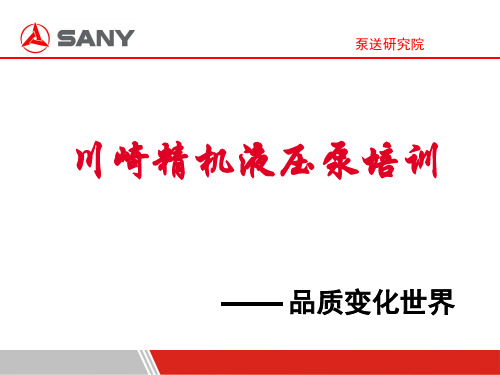
泵送研究院
川崎精机旳总企业工厂位于明石市向北约5公里, 建于神户市西端旳丘陵地带。有着液压行业第一 旳规模和设备,以液压泵·马达、操作器、阀等 液压机器为主,广泛生产全部机械·设备用液压 装置以及液压甲板机械、电动液压操舵机、液压 捕鱼机械等多种应用机械。
泵送研究院
1916·在川崎造船所·造机工厂(目前旳神户工厂),组装海伦-肖径向柱塞泵
泵送研究院
川崎重工 组织架构
泵送研究院
川崎重工 组织架构
泵送研究院
泵送研究院
川崎重工发展史
泵送研究院
川崎重工产品
泵究院
在向防卫省提供旳业务方面,以中级教练机T-4和固定翼巡查机P-3C系列为主。 在回转翼机方面,以日本最早旳国产直升机BK117为主。除了从事CH-47J/JA 型直升机、以及观察用直升机OH-1旳制造之外,还开始了MCH-101及南极运送 增援用直升机CH-101旳机身及发动机旳特许制造。
川崎重工产品-铁路车辆
泵送研究院
川崎重工自1923年着手铁路车辆制造。 在以新干线列车为代表旳高速车辆方面, 涉及特快列车、通勤列车、地铁列车、货 车、机车、单轨列车、新交通系统。在该 领域还从事振动•摇动控制系统、站台屏 蔽门系统旳开发等。
Kawasaki牌车辆也在美国生产。除了位于
川崎重工产品-船舶
1924·完毕电动液压操舵机 1936·开始制造、销售螺杆泵
川崎精机旳历史
1950·制造、销售纺丝用齿轮泵
1962·制造、销售斜轴形轴向柱塞泵、马达
1968·新设并搬迁到西神户工厂。成立液压机械业务部 开发斜盘式轴向柱塞泵、马达
1976·制造、销售高压型螺杆泵(B4型)
1986·设置川重液压株式会社,并向其移交液压机械业务部产品旳服务、维修业务
川崎泵的工作原理
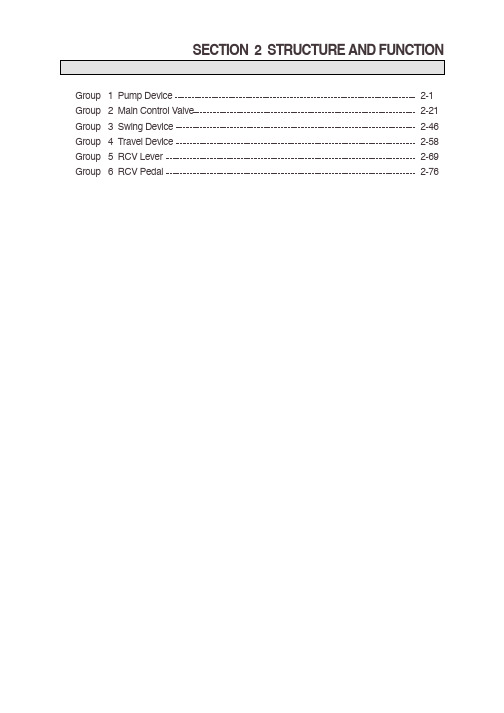
Group 1 Pump Device2-1 Group 2 Main Control Valve2-21 Group 3 Swing Device2-46 Group 4 Travel Device2-58 Group 5 RCV Lever2-69 Group 6 RCV Pedal2-761. STRUCTUREThe pump device consists of main pump, regulator and gear pump.The main pump consists of two piston pumps(front & rear) and valve block.04Gear pump 251Support710O-ring 111Drive shaft(F)261Seal cover(F)717O-ring 113Drive shaft(R)271Pump casing 724O-ring 114Spline coupling 312Valve block 725O-ring 123Roller bearing 313Valve plate(R)728O-ring 124Needle bearing 314Valve plate(L)732O-ring 127Bearing spacer 401Hexagon socket bolt 774Oil seal141Cylinder block 406Hexagon socket bolt 789Back up ring 151Piston 466VP Plug 792Back up ring152Shoe 468VP Plug 806Hexagon head nut 153Set plate 490Plug808Hexagon head nut 156Bushing531Tilting pin 824Snap ring 157Cylinder spring 532Servo piston 885Pin158Spacer 534Stopper(L)886Spring pin 211Shoe plate 535Stopper(S)901Eye bolt 212Swash plate 548Pin 953Set screw 214Bushing 702O-ring 954Set screw72872579Proportional reducing valve 541Seat 543Stopper 1544Stopper 2545Steel ball544543545541079VIEW APort A B Pi PmPort nameDelivery portSuction portPilot portQmax cut portport size3/4"2 1/2"PF 1/4-15PF 1/4-15VIEW C412Hexagon socket screw 413Hexagon socket screw 436Hexagon socket screw 438Hexagon socket screw 496Plug601Casing611Feed back lever612Lever(1)613Lever(2)614Fulcrum plug615Adjust plug621Compensator piston 622Piston case623Compensator rod 624Spring seat(C)625Outer spring626Inner spring627Adjust stem(C)628Adjust screw(C)629Cover(C)630Lock nut 631Sleeve, pf641Pilot cover642Pilot cover(QMC)643Pilot piston644Spring seat(Q)645Adjust stem(Q)646Pilot spring647Stopper648Piston(QMC)651Sleeve652Spool653Spring seat654Return spring655Set spring656Block cover708O-ring722O-ring723O-ring724O-ring725O-ring728O-ring730O-ring732O-ring733O-ring734O-ring735O-ring755O-ring756O-ring763O-ring801Nut814Snap ring836Snap ring858Snap ring874Pin875Pin887Pin897Pin898Pin924Set screw925Adjust screw(QI)GEAR PUMP 3)307Poppet 308Seat309Spring seat 310Spring 311Screw 312Nut351Gear case 353Drive gear354Driven gear355Filter361Front case433Flange socket434Flange socket435Flange socket466Plug700Ring710O-ring725O-ring732O-ring850Snap ring850 355Rotary groupThe rotary group consists of drive shaft (F)(111), cylinder block(141), piston shoes(151,152), set plate(153), spherical bush(156), spacer(158) and cylinder spring(157). The drive shaft is supported by bearing(123,124) at its both ends.The shoe is caulked to the piston to from a spherical coupling. It has a pocket to relieve thrust force generated by loading pressure and the take hydraulic balance so that it slides lightly over the shoe plate(211). The sub group composed by a piston and a shoe is pressed against the shoe plate by the action of the cylinder spring via a retainer and a spherical bush.Similarly, the cylinder block is pressed against valve plate(313) by the action of the cylinder spring.Swash plate groupThe swash plate group consists of swash plate(212), shoe plate(211), swash plate support(251), tilting bush(214), tilting pin(531) and servo piston(532).The swash plate is a cylindrical part formed on the opposite side of the sliding surface of the shoe and is supported by the swash support.If the servo piston moves to the right and left as hydraulic force controlled by the regulator is admitted to hydraulic chamber located on both sides of the servo piston, the swash plate slides over the swash plate support via the spherical part of the tilting pin to change the tilting angle()2. FUNCTIONMAIN PUMPThe pumps may classified roughly into the rotary group performing a rotary motion and working as the major part of the whole pump function: the swash plate group that varies the delivery rates: and the valve cover group that changes over oil suction and discharge.1)(1) (2)157211123111151152124313141158156153Valve block groupThe valve block group consists of valve block(312), valve plate(313) and valve plate pin(885).The valve plate having two melon-shaped ports is fixed to the valve block and feeds and collects oil to and from the cylinder block.The oil changed over by the valve plate is connected to an external pipeline by way of the valve block.Now, if the drive shaft is driven by a prime mover(electric motor, engine, etc), it rotates the cylinder block via a spline linkage at the same time. If the swash plate is tilted as in Fig(previous page) the pistons arranged in the cylinder block make a reciprocating motion with respect to the cylinder block, while they revolve with the cylinder block.If you pay attention to a single piston, it performs a motion away from the valve plate(oil sucking process) within 180degrees, and makes a motion towards the valve plate(or oil discharging process)in the rest of 180 degrees. When the swash plate has a tilting angle of zero,the piston makes no stroke and discharges no oil.(3)313885312Negative flow controlBy changing the pilot pressure Pi, the pump tilting angle(delivery flow) is regulated arbitrarily, as shown in the figure.This regulator is of the negative flow control in which the delivery flow Q decreases as the pilot pressure Pi rises.With this mechanism, when the pilot pressure corresponding to the flow required for the work is commanded, the pump discharges the required flow only,and so it does not consume the power uselessly.REGULATORRegulator consists of the negative flow control, total horse power control and power shift control function.2)(1) iAs the pilot pressure Pi rises, the pilot piston(643) moves to the right to a position where the force of the pilot spring(646) balances with the hydraulic force.The groove(A) in the pilot piston is fitted with the pin(875) that is fixed to lever 2(613). Therefore, when the pilot piston moves, lever 2 rotates around the fulcrum of point B [fixed by the fulcrum plug(614) and pin(875)]. Since the large hole section(C) of lever 2 contains a protruding pin(897) fixed to the feedback lever(611), the pin(897) moves to the right as lever 2 rotates. Since the opposing-flat section(D) of the feedback lever is fitted with the pin(548) fixed by the tilting pin(531) that swings the swash plate, the feedback lever rotates around the fulcrum of point D, as the pin(897) moves.Since the feedback lever is connected with the spool(652) via the pin(874), the spool moves to the right.The movement of the spool causes the delivery pressure P1 to connect to port CL through the spool and to be admitted to the large diameter section of the servo piston. The delivery pressure P1 that is constantly admitted to the small diameter section of the servo piston moves the servo piston to the right due to the area difference, resulting in decrease of the tilting angle. When the servo piston moves to the right, point D also moves to the right. The spool is fitted with the return spring(654) and is tensioned to the left at all times, and so the pin(897) is pressed against the large hole section(C) of lever 2.Therefore, as point D moves, the feedback lever rotates around the fulcrum of point C, and the spool is shifted to the left. This causes the opening between the sleeve(651) and spool(652) to close slowly, and the servo piston comes to a complete stop when it closes completely.As the pilot pressure Pi decreases, the pilot piston(643) moves to the left by the action of the pilot spring(646) and causes lever 2(613) to rotate around the fulcrum of point B. Since the pin(897) is pressed against the large hole section(C) of lever 2 by the action of the return spring(654) via the spool(652), pin(874), and feedback lever(611), the feedback lever rotates around the fulcrum of point D as lever 2 rotates, and shifts the spool to the left. Port CL opens a way to the tank port as the spool moves. This deprives the large diameter section of the servo piston of pressure, and shifts the servo piston to the left by the discharge pressure P1 in the small diameter section, resulting in an increase in the flow rate.As the servo piston moves, point D also moves to the left, the feedback lever rotates around the fulcrum of point C, and the spool moves to the right till the opening between the spool and sleeve is closed.The flow control characteristic can be adjusted with the adjusting screw.Adjust it by loosening the hexagon nut(801) and by tightening(or loosening)the hexagonal socket head screw(924).Tightening the screw shifts the control chart to the right as shown in the figure.Adjusting values are shown in table.Adjustment of flow control characteristic i801924Total horsepower controlThe regulator decreases the pump tilting angle(delivery flow) automatically to limit the input torque within a certain value with a rise in the delivery pressure P1 of the self pump and the delivery pressure P2 of the companion pump.(The input horsepower is constant when the speed is constant.)Since the regulator is of the simultaneous total horsepower type that operates by the sum of load pressures of the two pumps in the tandem double-pump system, the prime mover is automatically prevented from being overloaded,irrespective of the load condition of the two pumps, when horsepower control is under way.Since this regulator is of the simultaneous total horsepower type, it controls the tilting angles(displacement volumes) of the two pumps to the same value as represented by the following equation :Tin = P1¡q/2¬+ P2¡q/2¬= (P1+P2)¡q/2¬The horsepower control function is the same as the flow control function and is summarized in the following.(For detailed behaviors of respective parts, refer to the section of flow control).(2)Overload preventive functionWhen the self pump delivery pressure P1 or the companion pump delivery pressure P2 rises, it acts on the stepped part of the compensating piston(621). It presses the compensating rod(623) to the right till the force of the outer spring(625) and inner spring(626) balances with the hydraulic force. The movement of the compensating rod is transmitted to lever 1(612) via pin(875).Lever 1 rotates around the pin(875) (E) fixed to the casing(601).Since the large hole section(F) of lever 1 contains a protruding pin(897) fixed to the feedback lever(611), the feedback lever rotates around the fulcrum of point D as lever 1 rotates, and then the spool(652) is shifted to the right. As the spool moves, the delivery pressure P1 is admitted to the large diameter section of the servo piston via port CL, causes the servo piston move to the right, reduces the pump delivery, flow rate, and prevents the prime mover from being overloaded.The movement of the servo piston is transmitted to the feedback lever via point D. Then the feedback lever rotates around the fulcrum of point F and the spool is shifted to the left. The spool moves till the opening between the spool(652) and sleeve(651) is closed.Flow reset functionAs the self pump delivery pressure P1 or the companion pump delivery pressure P2 decreases, the compensating rod(623) is pushed back by the action of the springs(625 & 626) to rotate lever 1(612) around point E. Rotating of lever 1 causes the feedback lever(611) to rotate around the fulcrum of point D and then the spool(652) to move to the left. As a result, port CL opens a way to the tank port.This causes the servo piston to move to the left and the pump's delivery rate to increase.The movement of the servo piston is transmitted to the spool by the action of the feedback mechanism to move it till the opening between the spool and sleeve is closed.Adjustment of outer springAdjust it by loosening the hexagon nut(630) and by tightening(or loosening) the adjusting screw C(628).Tightening the screw shifts the control chart to the right and increases the input horsepower as shown in the figure. Since turning the adjusting screw C by N turns changes the setting of the inner spring(626), return the adjusting screw QI(925) by N¡ A turns at first.(A=2.2)Adjusting values are shown in tableLow tilting angle(Low flow) command preferential functionAs mentioned above, flow control and horsepower control tilting angle commands are transmitted to the feedback lever and spool via the large-hole sections(C & F) of levers 1 and 2.However, since sections C and F have the pins(¨4) protruding from the large hole(¨8), only the lever lessening the tilting angle contacts the pin(897) ; the hole(¨8) in the lever of a larger tilting angle command is freed without contacting the pin(897). Such a mechanical selection method permits preference of the lower tilting angle command of the flow control and horsepower control.Adjustment of input horsepowerSince the regulator is of total cumulative horsepower type, adjust the adjusting screws of both the front and rear pumps, when changing the horsepower set values. The pressure change values by adjustment are based on two pumps pressurized at the same time, and the values will be doubled when only one pump is loaded.a.Adjustment of outer springSpeedTightening Compens- Input torque amount of ating control change adjusting starting amount screw(C)pressure (924)changeamount(min -1)(Turn)(kgf/cm 2)(kgf¡m)2100+1/4+15.9+4.2b.Adjustment of inner spring Array Adjust it by loosening the hexagon nut (801) and by tightening(or loosening) the adjusting screw QI(925).Tightening the screw increases the flow and then the input horsepower as shown in the figure.Adjusting valves are shown in tablePower shift controlattached to the pump.valve is provided.horsepower level.This function permits arbitrary setting of the pump output power, thereby providing the optimum power level according to the operating condition.The power shift pressure Pf controls the set horsepower of the pump to a desired level, as shown in the figure.As the power shift pressure Pf rises, the compensating rod(623) moves to the right via the pin(898) and compensating piston(621).This decreases the pump tilting angle and then the set horsepower in the same way as explained in the overload preventive function of the horsepower control. On the contrary, the set horsepower rises as the power shift pressure Pf falls.(3)Adjust it by loosening the hexagon nut(808) and by tightening(or loosening)the set screw(954).The maximum flow only is adjusted without changing other control characteristics.Adjustment of minimum flowAdjust it by loosening the hexagon nut(808) and by tightening(or loosening)the hexagonal socket head set screw (953). Similarly to the adjustment of the maximum flow, other characteristics are not changed.However, remember that, if tightened too much, the required horsepower during the maximum delivery pressure(or during relieving) may increase.Adjustment of maximum and minimum flows (4)Adjustment of min flow Speed(min -1)2100Tightening amount of adjusting screw(953)(Turn)+1/4Flow change amount(/min )+4.8808954806953i(5)Qmax cut controlintermediate level.)Functional explanationAs shown in the figure, the pilot pressuresteps.When the pilot pressure Pm is given, it isadmitted to the lefthand side of thepiston QMC(648). The piston QMCmoves the stopper(647) and pilotpiston(643) to the right, overcoming theforce of the pilot spring(646), therebyreducing the delivery flow of the pump.Since the adjusting screw QMC(642) isprovided with a flange, the piston QMCstops upon contact with the flange, andthe position of the pilot piston at this timedetermines the maximum flow of thepump.Adjustment of Qmax cut flowAdjust it by loosening the hexagonnut(801) and by tightening(or loosening)the adjusting screw QMC(642).Tightening the screw decreases theQmax cut flow as shown in the figure.2-20。
川崎泵的工作原理

川崎泵的工作原理川崎泵是世界上知名的流量调节设备之一,应用于许多工业和商业领域。
所谓川崎泵就是指一种能够将液体或气体从一个容器转移到另一个容器的机械设备。
它通过应用物理和机械原理来转移液体或气体。
本文将详细讲述川崎泵的工作原理。
1. 川崎泵的主要组成部分川崎泵的主要组成部分包括泵体、叶轮、密封件、轴承和驱动器。
泵体是整个泵的主体部分,它的内部容积增大,从而使进口压力较低的液体或气体向高压部分流动。
叶轮是泵的核心部件,它会由马达或电动机带动旋转,进而推动纵向流动的流体。
密封件用于密封泵的出口和进口,以防止泄漏。
轴承用于支撑叶轮和驱动器的运动,保证泵的平衡和稳定。
驱动器则是泵的动力来源,提供能量以推动泵体和叶轮。
2. 川崎泵的工作原理在川崎泵的工作过程中,通常将液体或气体借助泵的叶轮进行转移。
泵体和叶轮间存在很小的隙缝,这个隙缝大小对川崎泵的性能影响很大。
通常情况下,隙缝越小,泵从一个区域向另一个区域的压力差就越小。
这将导致泵的工作效率降低,而且不适用于高粘度流体的处理。
因此,合理的隙缝可以使泵的性能达到最佳状态。
当启动川崎泵时,液体或气体从泵体口进入泵。
泵的内部密闭空间随后会产生负压,强制将液体或气体从进口吸入密闭空间。
这可以通过叶轮与驱动器的旋转来推动液体或气体,将它们从泵体的进口推到出口,向更高的压力区域移动。
绕流和密封件将压缩液体或气体向泵的出口推送。
然后,密封件将泵托盘和泵体连接起来,以保证造成泄漏。
最后,液体或气体从泵的出口喷出并进入用于转移或处理的容器。
3. 川崎泵的应用川崎泵在很多工业和商业领域中都得到了广泛应用。
例如,它可以应用于石油和天然气开采过程中,以将石油和天然气从井底提到地面。
此外,川崎泵也被应用于水系统中,以推动水从一个地方到另一个地方,疏通阀门和管道。
它还可以被用于泵送高粘度物料,如沥青,涂料,颜料,粘合剂和高浓度的化学液体。
总之,川崎泵是一种广泛应用的流量调节设备。
它的工作原理其实很简单,通过叶轮的旋转驱动液体或气体流动从而完成转移或处理。
川崎泵挖掘机培训教材.pptx

先导系统
• 先导泵(带安全阀)—给先导控制系统提供液压油 • 先导阀(手、脚先导阀)—按比例控制主阀动作 • 单向阀—保证蓄能器内的液压能不会泄掉 • 蓄能器—在发动机熄火后,提供液压能降下工作装置 • 电磁阀组(先导开关、行走换速、增力) • 功率控制电磁阀—控制液压系统功率
主操作阀原理图
主操作阀
为提高作业效率,提高构件运动速度,动臂提升,斗杆大小腔都实现双泵合流,其工 作原理如下:
斗杆合流
铲斗合流
斗杆再生回路,当斗杆无负载下落时,为提高斗杆运行速成度,
在斗杆油缸伸出时,把活塞杆腔的油引回大腔,实现再生功能,其 工作原理如下图:
行走直线功能,当挖掘机陷入坑中或其它特殊工况时,要求挖
液压油缸: 动臂油缸Ф120×Ф85×1285 2根 斗杆油缸Ф135×Ф95×1490 1根 铲斗油缸Ф115×Ф80×1120 1根
动臂油缸、斗杆油缸
铲斗油缸
活塞杆封-高压密封 B3型密封-耐磨性好、有润滑作用 支承环---支承、吸污 防尘圈---防尘
小腔节流原理
大腔节流原理
活塞密封
OK型密封,起主密封作用 支承环,每边两个,起支承、吸尘作用 活塞由螺母锁紧
• 9、春去春又回,新桃换旧符。在那桃花盛开的地方,在这醉人芬芳的季节,愿你生活像春天一样阳光,心情像桃花一样美丽,日子像桃子一样甜蜜。2 0.10.1820.10.18Sunday, October 18, 2020
挖掘机基本结构
挖掘机作业过程是以切削刃切削土壤,实现破 土、装土、提升回转、卸土,再返回第二次挖掘, 挖完一段后、机械移位后,继续挖掘
为实现上述周期性作业动作要求,就需要以下 组成部分:工作装置、回转机构、动力装置、传 动装置(液压部分)、操纵装置、行走装置等。 现通常按结构分为:回转平台、工作装置、行走
川崎K3V泵调节器动作

川崎K3V泵调节器动作1)通过泵的控制压力控制之与操作杆行程成比例的二级先导压力,在选择器阀中转化成压力Pi 后,进入泵的调节器。
泵调节器得知操作杆的状态,从而控制泵的斜盘角度。
控制结果有流量增加和流量减少两种。
2)通过自身或另一泵输油压力控制(恒扭矩控制)通过自身输油压力和另一泵输油压力进行泵控制,具有一下两种功能:流量减少(防过载)功能,流量增加(流量恢复)功能。
流量减少(防过载)功能,当负载(压力)增加时,泵流量减少,因此发动机不会过载。
流量增加(流量恢复)功能,当负载(压力)减少时,泵流量增加,因此发动机输出功率可得到有效利用。
3)通过来自功率控制电磁阀的先导压力控制(转速传感控制)当扭矩控制电磁阀(位于泵2的调节器上)提供扭矩控制压力P时,f泵流量减少。
4)通过来自泵最大流量限制电磁阀的先导压力控制(泵最大流量控制)通过来自泵最大流量限制电磁阀的先导压力控制的操作,与通过泵控制压力控制相同。
油路中的泵最大流根据来自MC(主控制器)的信号,泵控制压力Pi量限制电磁阀器起作用。
泵最大流量限制电磁阀起减压作用,限制泵控制压力Pi5)通过最大流量转换电磁阀控制(仅限泵1)当泵1最大流量转换电磁阀起作用时,作用在制动器上的泵1最大流进入液压邮箱,由于止动器向右移动,先导柱塞向右量转换压力Pic移动得要比一般情况下更多,使泵的最大流量增加。
6)较小斜盘角度或较小流量信号优先控制当泵流量增加和减少信号同时到达时,泵调节器动作,使流量减少信号优先。
由泵控制器提供泵排量角度控制信号,扭矩控制电磁阀提供先导压力,通过杆A和杆B上的孔以及销6传递到反馈杆和伺服阀芯上,销6与杆A或杆B上的流量减少侧与孔相接触,使流量和功率减少控制优先。
日本川崎公司工程机械用泵

1、排量问题 现象1:最大排量和最小排量打泵次数一样(单川崎泵)
序号
可能原因
判断方法
解决方案
1
电比例阀没电
测电比例阀输入线路
接好线路
2 减压阀P口与T口接反 测减压阀出口压力
对调P口与T口管路
3
减压阀P口无压力
测减压阀P口压力
解决进口压力问题
4 减压阀压力调整不合适 测减压阀出口压力
调整减压阀
5
电比例阀卡住
PPT文档演模板
日本川崎公司工程机械用泵
川崎斜盘型 K3V系列 轴向活塞泵
斜盘机构由斜盘、活塞瓦、斜板支持台、倾转缸衬、倾转销、 伺服 油缸构成。斜板在活塞瓦动作面的相反侧形成的圆筒状的部位上被支撑 在斜板支撑台上。由调节器控制的油压力,在活塞两侧的油压室的引导 作用下,使得活塞左右运动,此时借助于倾转销的球部,斜盘支持台上 摇动,可以改变倾转角。
(2) 分解前,仔细阅读维修要领书,按正确的顺序进行分解。
(3) 即使只分解某个部分,也要注意不要让灰尘进入。
(4) 部件都经过精密加工,工作时要注意不要碰伤。
PPT文档演模板
日本川崎公司工程机械用泵
川崎斜盘型 K3V系列 轴向活塞泵
8、泵体的异常的检查方法
泵内往往安装有调整器,附属阀,附属泵,虽然难以发现故障的原 因,但如按以下几项大的项目进行调查,异常部分便可查明。
1
卡死 力正常,调整 阀尾部螺钉,在a2口接上压力表,慢慢拧入M6螺钉
排量,观察a2 ,到a2口压力为2.0-2.2MPa(70%左右排量)时锁。
口压力变化
彻底方案:更换电比例阀
更换时用扳手从此处旋出
电比例阀尾部螺钉
PPT文档演模板
川崎液压系统精ppt课件

先导阀
多路阀
斜盘式轴向柱塞泵
斜盘式轴向柱塞马达
.
双速行走马达
挖掘机系统介绍
.
Bypass
Zero Full
1.负流量控制系统
斗杆 (2) 铲斗 动臂 (1) 备用 行走(右) 直线行走阀 行走 (左) 回转 斗杆 (1) 动臂(2)
.
PN
Zero Full
Bypass
脚先导阀 手先导阀
吸. 油管
泵测压口
一、主液压管路介绍(主泵负流
• 主控阀中位有回油 时,通过负反馈阀
量调节)
负反馈油口Pi1:接主阀上FL口
组的节流孔,使油
液在节流孔前后产
生压力差
• 将节流孔前的压力
引至泵调节器来控
制泵的排量
Psv口
负反馈油口Pi2:接主阀上FR口 .
开式回路 Prated 350 bar Peak 400 bar
行走马达
回转马达 斗杆油回缸 转优先阀
手先导阀 脚先导阀
控制阀
当斗杆收回和回转同时进行时 回转开始的压力由回转优先阀保持 → 可以同时进行斗杆收回和回转.
发动机
负流量控制信号
泵
负流量控制信号
.
再生
铲斗油缸
(斗杆缩进、动臂下降)
脚先导阀 手先导阀
动臂油缸
行走马达
回转马达 斗杆油缸
再生回路中的斗杆
手先导阀 脚先导阀
63 cm3/rev 112 cm3/rev 140 cm3/rev 180 cm3/rev 280 cm3/rev
K3V 柱塞泵系列
压力补偿 力矩限制 排量控制 负载敏感 & 混合
.
川崎泵控制阀结构原理说明k3v(中文版2)
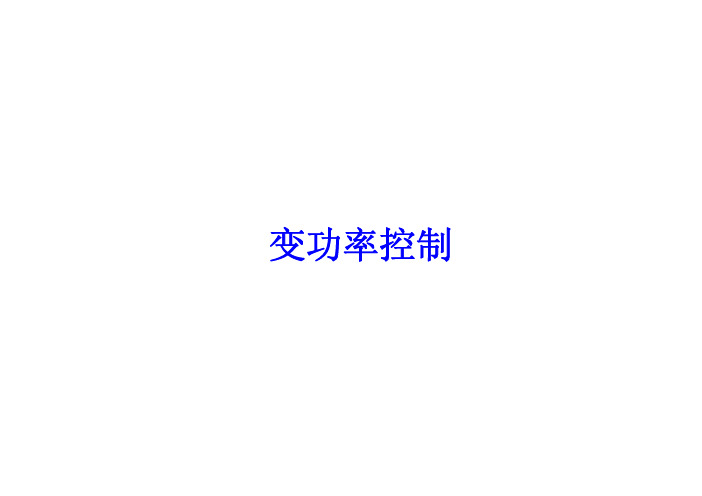
-1
P1
负流量控制
A1
Pi Pm1
Pi
Dr
P1
负流量控制
A1
Pi Pm1
Pi
Dr
P1
负流量控制
A1
Pi Pm1
Dr
P1
负流量控制
A1
Pi Pm1
Dr
P1
负流量控制
A1
α
Pi Pm1
max
α
min
12bar
32bar
Pi
Dr
P1
负流量控制
A1
α
Pi Pm1
12bar 32bar
Pi
Dr
P1
负流量控制
A1
α
Pi Pm1
12bar 32bar
Pi
Dr
P1
负流量控制
A1
α
Pi Pm1
12bar 32bar
Pi
Dr
P1
A1
负流量控制
α
Pi Pm1
12bar 32bar
Pi
Dr
P1
负流量控制
A1
α
Pi Pm1
12bar 32bar
Pi
D
r Dr
P1
负流量控制
A1
α
Pi Pm1
12bar 32bar
Pi
Dr
P1
负流量控制
A1
α
Pi Pm1
12bar 32bar
Pi
Dr
两级最大流量控制
P1
两级最大流量控制
A1
Pi Pm1
1负流量控制国产中型挖掘机主泵总成(川崎K3V112DT)结构原理分析
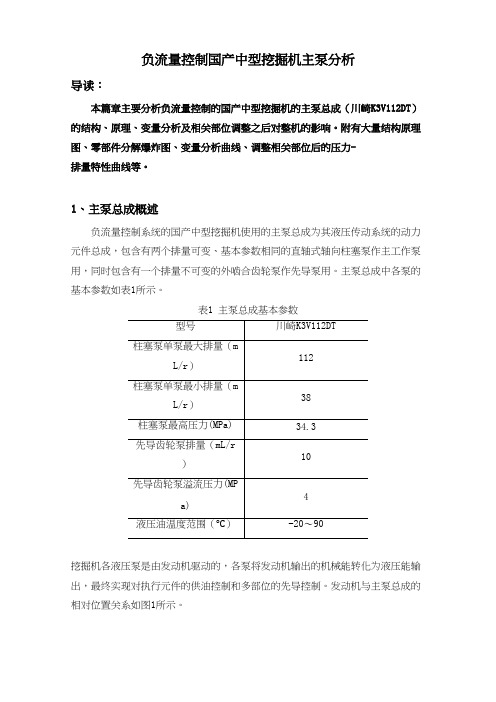
16-O型圈;17-辅助活塞;18-O型圈;19-垫片;20-调节器;21-倾斜销;22泵壳体;
23-螺堵;24-O型圈;25-伺服活塞;26-垫片;27-O型圈;28-辅助活塞;29斜盘座;
30-衬套;31-斜盘;32-滑靴;33-柱塞;34-滑靴压板;35-球面衬套;36衬套垫圈;
负流量控制国产中型挖掘机主泵分析
导读:
本篇章主要分析负流量控制的国产中型挖掘机的主泵总成(川崎K3V112DT) 的结构、原理、变量分析及相关部位调整之后对整机的影响。附有大量结构原理 图、零部件分解爆炸图、变量分析曲线、调整相关部位后的压力排量特性曲线等。
1、主泵总成概述
负流量控制系统的国产中型挖掘机使用的主泵总成为其液压传动系统的动力
(前泵输出的油液可流经左行走、回转、动臂2(动臂副联)及斗杆1(斗杆主联 )的主换向阀芯,后泵输出的油液可流经右行走、备用(破碎锤或液压剪等)、 动臂1(动臂主联)、铲斗及斗杆2(斗杆副联)的主换向阀芯)
图3 主泵总成各部件位置及名称 对于前泵与后泵,每个泵均由泵体、输入轴、缸体、(九个带滑靴结构的) 柱塞、配流盘、斜盘、伺服活塞及对应泵调节器等组成,柱塞头部(即滑靴表面 )紧贴斜盘表面。双柱塞泵共用一个中间体,在中间体上布置有一个双泵共用的 吸油口,并布置有两个泵对应的出油口。从轴侧看,工作中,主轴顺时针旋转。 以前泵为例,如图4所示,(从轴侧看)输入轴顺时针旋转,带动缸体顺时 针旋转,因柱塞均在缸体的柱塞孔内,且柱塞头部紧贴斜盘,故在缸体在作旋转 运动的同时,柱塞一方面会随缸体作旋转运动,另一方面将在缸体的柱塞孔内作 往复直线运动,造成(缸体柱塞孔内的)柱塞尾部密封容腔交替变换,密封容腔 变大时,产生真空度,经配流盘吸油区通过中间体吸油口吸油;密封容腔变小, 即可从配流盘压油区通过泵中间体出油口向外排油,此时泵出口排油压力取决于 外负载(即排油阻力)。该型主泵的伺服活塞可带动斜盘摆动,以带动泵内部柱 塞改变有效行程,最终改变泵排量,以实现主泵工作过程中液压系统功率与发动 机功率的匹配。
川崎液压系统(课堂PPT)

行走马达
回转马达 斗杆油回缸 转优先阀
手先导阀 脚先导阀
控制阀
当斗杆收回和回转同时进行时 回转开始的压力由回转优先阀保持 → 可以同时进行斗杆收回和回转.
泵 发动机
负流量控制信号
负流量控制信号
11
再生
铲斗油缸
(斗杆缩进、动臂下降)
脚先导阀 手先导阀
动臂油缸
行走马达
回转马达 斗杆油缸
再生回路中的斗杆
挖掘机用液压部件
先导阀
多路阀
斜盘式轴向柱塞泵
斜盘式轴向柱塞马达
双速行走马达
1
挖掘机系统介绍
2
Bypass
Zero Full
1.负流量控制系统
斗杆 (2) 铲斗 动臂 (1) 备用 行走(右) 直线行走阀 行走 (左) 回转 斗杆 (1) 动臂(2)
3
PN
Zero Full
Bypass
脚先导阀 手先导阀
泵 回转马达 控制阀 伺服阀
:K3V 系列 :M5X 系列 :KMX 系列 :TH 系列 (手先导阀)
PVD系列 :RCV 系列 (脚先导阀)
17
斜盘柱塞泵
18
K3V 串联式柱塞泵
for mobile applications
19
主泵原理图 Main pump drawings
20
K3V 系列
手先导阀 脚先导阀
控制阀
动臂阀芯和斗杆阀芯有再生回路 使用部分回流. →节能.
泵 发动机
负信号控制
负信号控制
12
锁定阀 (斗杆 &动臂)
先导压 力
Deactivated
13
发动机转速传感系统
川崎泵的原理与调整

现在的挖掘机多为斜盘式变量双液压泵,所谓变量泵就是泵的排量可以改变,它是通过改变斜盘的摆角来改变柱塞的行程从而实现泵排出油液容积的变化。
变量泵的优点是在调节范围之内,可以充分利用发动机的功率,达到高效节能的效果,但其结构和制造工艺复杂,成本高,安装调试比较负责。
按照变量方式可分为手动变量、电子油流变量、负压油流变量、压力补偿变量、恒压变量、液压变量等多种方式。
现在的挖掘机多采用川崎交叉恒功率调节系统,多为反向流控制,功率控制,工作模式控制(电磁比例减压阀控制)这三种控制方式复合控制。
下载(44.84 KB)前天21:51调节器代码对应的调节方式下载(64.54 KB)前天21:51调节器内部结构各种控制都是通过调节伺服活塞来控制斜盘角度,达到调节液压泵流量的效果。
大家知道在压强相等的情况下,受力面积的受到的作用力就大。
下载(25.52 KB)前天21:52调节器就是运用这一原理,通过控制伺服活塞的大小头与液压泵出油口的联通关闭来控制伺服活塞的行程。
在伺服活塞大小头腔都有限位螺丝,所以通过调节限位螺丝可以调节伺服活塞最大或最小行程,达到调节液压泵的最大流量或者最小流量的效果。
下载(55.63 KB)前天21:51向内调整限制伺服活塞最大和最小行程及限制最大流量和最小流量要谈谈反向流控制,就必须要弄明白反向流是如何产生的。
在主控阀中有一条中心油道,当主控阀各阀芯处于中位时(及手柄无操作时)或者阀芯微动时(及手柄微操作时)液压泵的液压油通过中心油道到达主控阀底部溢流阀,经过底部溢流阀的增压产生方向流(注当发动机启动后无动作时液压回路是直通油箱,液压系统无压力)。
下载(57.08 KB)昨天00:30所以方向流控制的功能是减少操作控制阀在中位时,泵的流量,使泵流量随司机操作所属流量变化,改善调速性能,避免了无用能耗。
大家注意方向流控制并非交叉控制,一个泵对应一个主控阀块(一般主控阀都为双阀块)。
如果单边手柄动作速度很慢特别是回转和铲斗奇慢,复合动作正常一般就是反向流油管安装反了。
川崎主泵构造原理及调试
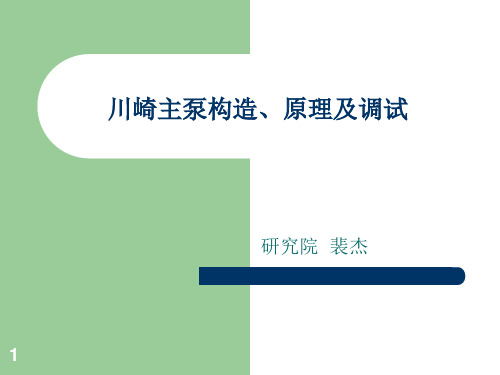
川崎主泵动作原理(二)
8
调 节 器 的 结 构 1
9
调 节 器
的 结 构
2
压力
切断
10
调 节 器 的 结 构 3
11
恒功率调节: 泵
送压力低于折点 压力时,调节外弹 簧;泵送压力高 于折点压力时,调
节内弹簧。
调节器的原理及调节
1、恒功率工作原理及调节:
2、排量控制的工作原理:
泵送压力
排量控 制压力
调节器拆装步骤
25
调节器拆装步骤
26
调节器拆装步骤
27
调节器拆装步骤
28
调节器拆装步骤
29
谢谢观赏!
川崎主泵构造、原理及调试
研究院 裴杰
1
川崎主泵构造、原理及调试
川崎主泵型号表示 川崎主泵液压原理 川崎主泵结构图 调节器的原理及调节 川崎主泵的拆卸
2
川崎主泵的型号表示
3
川崎主泵液压原理
4
川崎主泵结构图(图一)
5
川崎主泵结构图(图二)
压力切断 恒功率调整
6
川崎主泵动作原理(一)
12
川崎泵的调试 调节器的调整
13
川崎泵的调试 调节器的调整
14
川崎泵的调试 调节器的调整
15
川崎泵的调试 调节器的调整
16
川崎主泵拆步骤
17
川崎主泵拆步骤
18
川崎主泵拆步骤
19
川崎主泵拆步骤
20
川崎主泵拆步骤
21
调节器拆装步骤
22
调节器拆装步骤
23
调节器拆装步骤
24
挖掘机培训教材液压(川崎系统)

液压马达是液压系统中的执行元件,它通过将油液的压力能转化为机械能来驱动负载运动。
在液压马达中,油液经过叶片或活塞的挤压作用,将油液的压力能转化为旋转运动或直线运动的机械能。
液压马达的工作原理
油箱是液压系统中的油液储存和散热元件,它通常由金属板制成,内部装有隔板或滤网等,以实现油液的沉淀和过滤。
1
2
3
检查控制阀的安装是否正确,阀芯是否磨损,需要更换。
控制阀无法正常工作
检查控制阀的密封圈是否老化或损坏,需要更换。
控制阀泄漏
检查控制阀的润滑是否良好,需要添加润滑油。
控制阀噪音过大
控制阀常见故障及排除方法
03
液压马达噪音过大
检查液压马达的润滑是否良好,需要添加润滑油。
01
液压马达无法正常转动
挖掘机培统的工作原理 川崎液压系统的维护与保养 川崎液压系统常见故障及排除方法 挖掘机操作中的川崎液压系统应用
01
CHAPTER
川崎液压系统简介
川崎液压系统的特点
高效率
川崎液压系统采用先进的液压技术,具有高效率和低能耗的特点,能够提高挖掘机的作业效率和降低运营成本。
02
CHAPTER
川崎液压系统的工作原理
01
02
液压泵的工作原理
在液压泵中,油液经过叶片或活塞的挤压作用,将机械能转化为油液的压力能,从而实现油液的输出。
液压泵是液压系统的动力源,它通过机械能将油液从油箱中吸入,再通过压力将油液输出到系统中。
控制阀的工作原理
控制阀是液压系统中的控制元件,它通过改变油液的流向和流量来控制执行元件的运动。
9.3-1川崎主油泵调试工艺
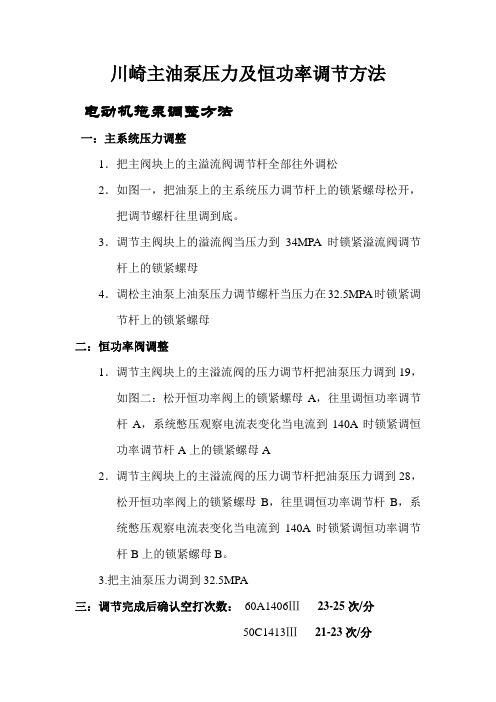
川崎主油泵压力及恒功率调节方法电动机拖泵调整方法一:主系统压力调整1.把主阀块上的主溢流阀调节杆全部往外调松2.如图一,把油泵上的主系统压力调节杆上的锁紧螺母松开,把调节螺杆往里调到底。
3.调节主阀块上的溢流阀当压力到34MPA时锁紧溢流阀调节杆上的锁紧螺母4.调松主油泵上油泵压力调节螺杆当压力在32.5MPA时锁紧调节杆上的锁紧螺母二:恒功率阀调整1.调节主阀块上的主溢流阀的压力调节杆把油泵压力调到19,如图二:松开恒功率阀上的锁紧螺母A,往里调恒功率调节杆A,系统憋压观察电流表变化当电流到140A时锁紧调恒功率调节杆A上的锁紧螺母A2.调节主阀块上的主溢流阀的压力调节杆把油泵压力调到28,松开恒功率阀上的锁紧螺母B,往里调恒功率调节杆B,系统憋压观察电流表变化当电流到140A时锁紧调恒功率调节杆B上的锁紧螺母B。
3.把主油泵压力调到32.5MPA三:调节完成后确认空打次数:60A1406Ⅲ23-25次/分50C1413Ⅲ21-23次/分柴油机机拖泵调整方法一:主系统压力调整1.把主阀块上的主溢流阀调节杆全部往外调松2.如图一,把油泵上的主系统压力调节杆上的锁紧螺母松开,把调节螺杆往里调到底。
3.调节主阀块上的溢流阀当压力到34MPA时锁紧溢流阀调节杆上的锁紧螺母4.调松主油泵上油泵压力调节螺杆当压力在32.5MPA时锁紧调节杆上的锁紧螺母二:恒功率阀调整1.调节主阀块上的主溢流阀的压力调节杆把油泵压力调到19MPA,如图二:松开恒功率阀上的锁紧螺母A,往里调恒功率调节杆A,系统憋压观察发动机转速变化,当发动机掉速至150rpm时锁紧调恒功率调节杆A上的锁紧螺母A2.调节主阀块上的主溢流阀的压力调节杆把油泵压力调到28MPA,松开恒功率阀上的锁紧螺母B,往里调恒功率调节杆B,系统憋压观察系统憋压观察发动机转速变化,当发动机掉速至150rpm时锁紧调恒功率调节杆B上的锁紧螺母B。
3.把主油泵压力调到32.5MPA(参照系统压力调整)三:调节完成后确认空打次数:60C1816DⅢ(低压)19-21次/分图一排量比例电磁铁川崎主油泵调节阀主系统压力调节杆恒功率调节杆图一图二锁紧螺母A恒功率调节杆A锁紧螺母B恒功率调节杆B。
- 1、下载文档前请自行甄别文档内容的完整性,平台不提供额外的编辑、内容补充、找答案等附加服务。
- 2、"仅部分预览"的文档,不可在线预览部分如存在完整性等问题,可反馈申请退款(可完整预览的文档不适用该条件!)。
- 3、如文档侵犯您的权益,请联系客服反馈,我们会尽快为您处理(人工客服工作时间:9:00-18:30)。
调节器拆装步骤
调节器拆装步骤
川崎主泵动作原理(二)
调 节 器 的 结 构 1
调 节 器 的 结 构 2
压力 切断
调 节 器 的 结 构 3
恒功率调节: 泵 送压力低于折点 压力时,调节外弹 簧;泵送压力高 于折点压力时,调 节内弹簧。
调节器的原理及调节
1、恒功率工作原理及调节:
2、排量控制的工作原理:
泵送压力
排量控 制压力
川崎主泵构造、原理及调试
研究院 裴杰
川崎主泵构造、原理及调试
Байду номын сангаас
川崎主泵型号表示 川崎主泵液压原理 川崎主泵结构图 调节器的原理及调节 川崎主泵的拆卸
川崎主泵的型号表示
川崎主泵液压原理
川崎主泵结构图(图一)
川崎主泵结构图(图二)
压力切断
恒功率调整
川崎主泵动作原理(一)
川崎泵的调试 调节器的调整
川崎泵的调试 调节器的调整
川崎泵的调试 调节器的调整
川崎泵的调试 调节器的调整
川崎主泵拆步骤
川崎主泵拆步骤
川崎主泵拆步骤
川崎主泵拆步骤
川崎主泵拆步骤
调节器拆装步骤
调节器拆装步骤
调节器拆装步骤
调节器拆装步骤
调节器拆装步骤
调节器拆装步骤
